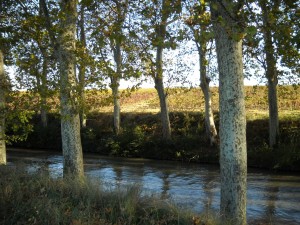Pollarding Trees
On a recent trip to southern France I was fascinated by what some people might term “tree abuse”. The French love to turn certain trees into sculpted forms by removing all new growth each year – or most, depending on the age of the tree. The English term for this type of pruning is “pollarding”. I have decided I shall give it a try.
The English plane tree (Platanus x. acerifolia) is the most commonly pollarded tree in southern France, though I have seen other fast-growing trees treated the same way, notably lindens (Tilia spp). Plane trees are reminiscent of our sycamores (Platanus occidentalis), with bark that looks a bit like the patterns and colors of camouflage clothing. They are commonly used to line city streets and rural lanes.
The plane tree is fast growing and survives in most places – even along the Canal du Midi, the seventeenth-century canal that connects the Mediterranean to the Atlantic. I spent a day biking the canal and was amazed to see plane tree roots cross the towpath and reach into the water – like pythons slithering out of the earth and into the canal. But I noticed that the plane tree sheds branches freely, dropping small branches onto my path. I gather it is a somewhat weak-wooded tree, though perhaps not as weak as our willows (Salix spp.) or box elder (Acer negundo).
Driving through the town of Puisserguier, in the Languedoc, I admired the ‘allees’ or rows of plane trees that lined their streets. Then one day I came back and saw that all new growth had been cut off, creating an eerie, Edward Gorey-like atmosphere. Workers with a boom truck were just finishing up a major task, clearing out the clutter by cutting off all the upper branches.
These big trees showed huge knobs, scars where this had been done many times. I spoke to a tree specialist, who explained that plane tree branches can grow 6-9 feet per year, so they cut off all new growth on mature trees every other year. By cutting back the smaller branches to the trunk or a major branch, much weak wood is eliminated and weight taken off the major branches. It keeps trees from getting too tall. And it creates wonderful sculpture.
Another benefit of pollarding a tree is that it creates dense shade. Cutting back the trees encourages them to send out multiple shoots. From the scarred knobs created in previous years, a half dozen branches will erupt. That creates dense foliage. The Mediterranean sun is hot in summer, and town squares are generally shaded from its intensity by pollarded plane trees, much as our American elms once shaded Main Street.
When I return from France I will experiment with my seven-sons flower tree (Heptacodium micinioides). This is a fast-growing tree that blooms in the fall; the blossoms are small, white and lightly fragrant. It is originally from China, and has only started to become popular in the nursery trade in the last 20 years. I got mine about 10 years ago at EC Brown Nursery in Thetford, Vermont (www.ecbrownsnursery.com).
It is a medium-sized tree – the largest specimen I’ve seen is about 30 feet tall. But it can send up shoots 6 feet in a year, and I have struggled to keep mine the size and shape I want. It is near the house and several times it has attempted to send shoots indoors through a second-floor window. So I have pruned it hard, but never removed enough branches to create a pollarded look. The main trunk is now about 4-inches or more in diameter and 10 feet tall. It has one major bifurcation – where the trunk branches into 2 major branches. So I will cut off all the branches back to those two branches. Later, I may let a single new stem continue to grow and thicken, creating a higher point for pollarding.
So what else have I learned in France? I think I pamper some of my plants too much. I know that thyme, rosemary and lavender thrive in lean soil that is low in fertility. But it is hard for me to deny them some compost at planting time. Off-road biking here I have found them growing wild – thriving – in sandy dry soil, which should be a lesson to me.
Similarly, grapes here do fabulously in dry, rocky soil. One vintner, an organic grower at Domaine Bordes (A.O.C. Saint Chinian) told me that he uses no fertilizer. He said that his grapes do just fine, producing great flavor – but in smaller quantities than conventional growers who use chemical fertilizers. Grape growers often mulch with gravel in France, a technique I haven’t yet tried.
Lastly, I saw sheep’s wool used as mulch around trees. There is not much market for raw wool in France – or in the States. If you have a friend with sheep or llamas, you might be able to get some wool. It will keep down weeds, hold in moisture, and slowly break down, providing some nitrogen. Still, I’m not sure I like the look – perhaps it would be good in my blackberry patch, or around apple trees that are not in view every day.
So if you travel, observe. And send me your observations – we can all learn new techniques from each other, and from different cultures.
Contact Henry at henry.homeyer@comcast.net or P.O. Box 364, Cornish Flat, NH 03746.




